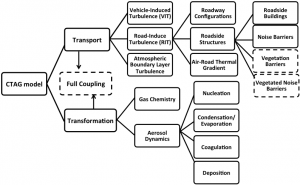EERL has pioneered the development and application of advanced analytical tools in solving micro-environmental air quality problems. Our modeling framework is called Comprehensive Turbulent Aerosol Dynamics and Gas Chemistry (CTAG), a computational fluid dynamics (CFD)-based environmental turbulent reacting flow model designed to simulate the transport and transformation of multiple air pollutants in complex environments.
 CTAG was initially developed for transportation air quality applications. On the transport side, it is designed to capture the major turbulent mixing processes in the roadway environments: vehicle-induced turbulence (VIT) and road-induced turbulence (RIT) and atmospheric boundary layer turbulence (ABLT). On the transformation side, currently CTAG has incorporated NOx chemistry and aerosol processes such as nucleation, condensation and evaporation, and coagulation. The important transportation air quality applications include developing mitigation strategies to near-road air pollution, quantifying the impacts of roadside solid and vegetation barriers, and understanding the roles of on-road chemistry on near-road NOx concentrations.
CTAG was initially developed for transportation air quality applications. On the transport side, it is designed to capture the major turbulent mixing processes in the roadway environments: vehicle-induced turbulence (VIT) and road-induced turbulence (RIT) and atmospheric boundary layer turbulence (ABLT). On the transformation side, currently CTAG has incorporated NOx chemistry and aerosol processes such as nucleation, condensation and evaporation, and coagulation. The important transportation air quality applications include developing mitigation strategies to near-road air pollution, quantifying the impacts of roadside solid and vegetation barriers, and understanding the roles of on-road chemistry on near-road NOx concentrations.
Recently, the capability of the CTAG model has been extended to simulate the evolution of electric generating units (EGUs), including large coal-fired power plants and distributed energy resources (DERs), e.g.,diesel backup generators, small combustion turbines, and biomass combined and heat power (CHP) units.
An ongoing project allows us to test the capability of the CTAG model in capturing the impacts of woodsmoke in urban and rural areas.
